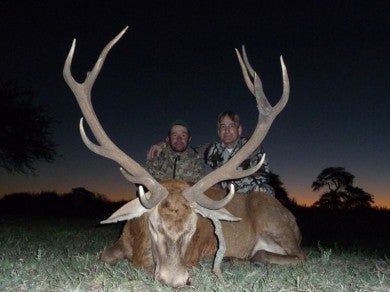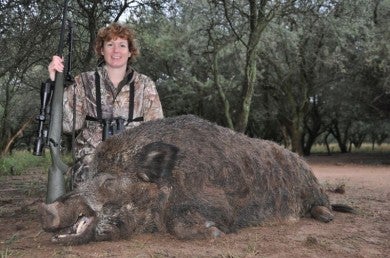Hunting Red Stag in La Pampa, Argentina
Andy Hahn 04.07.14
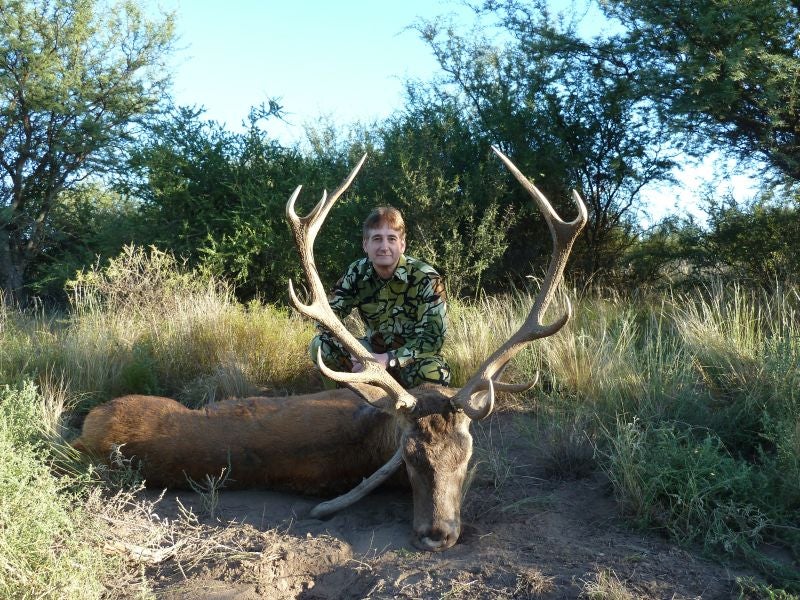
Keeping the steady breeze in our favor, my guide, Carlos, and I quietly stalked through the thick brush. Suddenly a loud, long bellow shattered the early morning stillness and stopped us in our tracks. Sounding more like a rabid Rottweiler than a lovesick deer, the unseen stag issued a guttural warning to all others that dare even think of getting near its harem. Another thunderous blast boomed out of the heavy cover just 20 yards ahead of us.
AARROOOAUW-OUGH-OUGH-OUGH!
After such an up-close performance, I fully understood the terminology that describes the vociferous rutting behavior of two of the deer family’s larger members. An elk bugles; a red stag roars.
My early April trip to central Argentina’s province of La Pampa coincided with the peak of roaring season (or brama, as Argentines call it) at the beginning of South America’s autumn. No flaming fall colors here, however. Parched from a long, windy summer, the level landscape consisted of dry grass and clusters of low-growing, flat-topped caldén trees with dark green leaves.
Upon entering the brush on the first afternoon of my hunt, I realized the terrain had deceived my hunter’s eye. At first glance the cover seemed sparse, and I didn’t think we’d be able to sneak within 100 yards of a stag. But the caldén grew in thick stands and scattered clumps that limited clear visibility to 40 yards or less.
Knee-high grass filled open areas like a wavering blanket of eternal, ethereal ground fog. We often took advantage of this additional layer of concealment by sneaking along on hands and knees; when we crouched, our camo-clad forms resembled stray bushes.
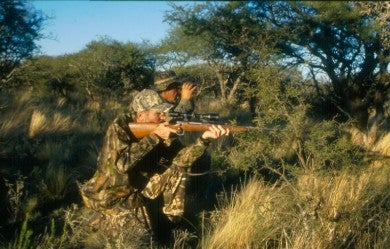
We’d catch glimpses of rust-colored hinds (female red deer) and darker-bodied stags as they ghosted through the thickets. Finally we spotted a stag with a tall, wide rack. This monarch possessed a harem of about six hinds, and they seemed to be late for an appointment. They weren’t spooked, but they kept moving at a brisk clip.
At least three times I set up to shoot when the deer headed toward openings in the brush. Every time, however, the stag hustled through the shooting lane too quickly for me to draw a confident bead. And every time I passed up a risky shot, Carlos understood my reasons. He’d just say, “Tranquilo,” and we’d resume stalking.
We gave up the chase at nightfall and several roaring stags serenaded us during the walk back to the ranch house. My wife and I heard a few more roars as we sipped wine on the porch and gazed up at the stars after dinner.
Buen Tiro!
A light frost covered the predawn ground when Carlos and I headed out the next morning. We walked about a mile down the dirt road and then turned north to enter a wooded area. With a stag roaring nearby, Carlos flipped open his lighter and confirmed that the breeze remained steady out of the east. We circled well downwind of the stag’s position before beginning pursuit at first light.
I can’t accurately describe our approach as “spot and stalk” because we hadn’t actually made visual contact with any animals. Instead, we relied on the stag’s frequent vocalizations to reveal its constantly changing position in the thick cover. We only realized how close we were when it let out a royal, top-of-its-lungs roar.
AARROOOAUW-OUGH-OUGH-OUGH!
Although the stag hadn’t perceived our presence, the aggressive war cry stopped us cold. I felt it rattle inside my chest like the booming drum section of a marching band.
Careful stalking for the next half-hour rewarded us with occasional flashes of reddish hair or antlers disappearing behind a shrub. As we approached a slightly more open area, Carlos suddenly crouched. The stag stood at the edge of a small clearing.
I dropped to my right knee, shouldered the ’06 and rested my left elbow on my left knee. The stag hadn’t seen us, but it quick-stepped after several hinds that moved along at their deceptively fast trot. I had trouble keeping the restless deer in the scope. Sensing this, Carlos let out a short, sharp hiss.
Pssssst!
The stag froze, just 40 yards away, head turned toward us. I peered through the scope helplessly, unable to pull the trigger because a small tree blocked my view of the deer’s body and I couldn’t risk a shot. Carlos couldn’t see this from his position, and later told me he was wondering why in the heck I didn’t shoot. Growing antsy, the stag began moving forward; a few more steps and it would disappear in the trees. Carlos emitted a low grunt like a challenging intruder.
That did the trick. The stag stopped broadside to glare at us and I felt like a mere spectator as the crosshairs settled behind its left foreleg. I can’t remember sending a conscious order to my finger to squeeze the trigger.
BAM!
My head went hazy, as if some of that eternal ground fog had seeped between my ears. In a daze, I heard Carlos excitedly say, “Buen tiro, buen tiro!” Good shot!
Automatically racking the rifle bolt and flicking on the safety, I groggily realized that my shooting posture had been less than perfect when I crouched to hide in the grass. At the shot, the scope had smacked my eyeglasses and gouged the bridge of my nose.
Carlos reached down and picked up something. The left lens of my glasses had popped out. Well, that explained my blurry vision. Then he saw blood dripping off my schnoz and went into a Keystone Cops routine: two steps toward the deer to see if it was dead, then a quick shuffle back to make sure I’d survive my injury. I finally shook the cobwebs out of my head and stuffed the lens in my pocket. At least I still had corrected vision for my right eye if I needed to deliver a follow-up shot.
Our cautious, arms-at-ready approach proved unnecessary because the stag had gone down instantly. Carlos shook my hand—and offered a tissue to blot my bleeding nose—as we silently admired the wide, symmetrical 5 x 5 rack. Then I realized this magnificent deer was the same one we’d pursued in the previous evening’s fading light.
That night we toasted my ciervo colorado with shots of chilled Jägermeister. I’d brought the bottle specifically for this occasion because the name translates as “master hunter” and the label bears a portrait of a red stag.
I had the skull of my first red stag bleached for a European mount. Every time I pause to appreciate the trophy now hanging on my wall, I can still hear its mighty roar.
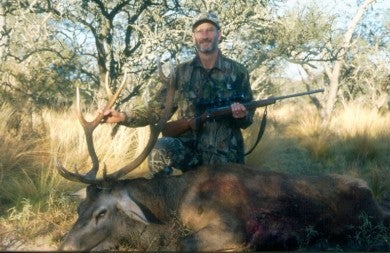
A Different Game
Although elk (Cervus canadensis) and red deer (Cervus elaphus) are closely related—the two species can interbreed—each involve distinct hunting scenarios. “Hunting the roar for free-ranging red stags in La Pampa was definitely an eye opener for me,” says TJ Schwanky, veteran elk hunter and host of Outdoor Quest TV.
During their April 2012 trip, Schwanky handled the camera while his wife, Vanessa Harrop, did the hunting. They discovered that although frequent roaring makes stags rather easy to locate, getting a shot at one in La Pampa’s heavy cover is a completely different matter. “Unlike North American elk, which often bugle from one spot for extended periods of time, red stags and their hinds seem to stay on the move. Stalking them is a balancing act,” Schwanky says. “You must go quickly enough to keep up with them but not so fast that they detect you. It’s common to get within 30 yards of a stag and still not be able to see it in the thick brush, and shots typically require threading a bullet through small openings in the branches. It’s exhilarating to get so close to a roaring stag that you can almost smell its breath, but frustrating when you can’t see a hair on its body. I never imagined the hunt would be so challenging.”
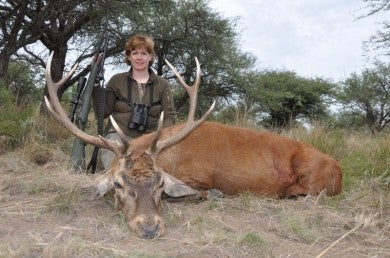
Back for More
Fair warning: The challenge of stalking stags is addictive. Mike Malek, of Michigan, first visited La Pampa in 2005 and has returned every year since. To support his habit, he now sells hunts for an Argentine outfitter.
“As a bowhunter, I appreciate the dense cover in La Pampa because it allows me to stalk within range of an ethical shot,” Malek says. “There’s nothing like hearing the roar of a red stag at 30 yards. After all the times I’ve hunted them, it still sends shivers down my spine.”
Malek rates the region’s relatively flat landscape as a major advantage. “The terrain is a mix of rolling hills, scrub, and mature forest interspersed with open grassland. At just 600 feet above sea level, even an older guy like me can get out there and hunt comfortably,” he says.
Like Malek, my first red stag hunt occurred in 2005; I didn’t expect to return, however, because I was diagnosed with ALS shortly afterward. Through the years I stayed in touch with my guide, Carlos Martinez, and he was aware of my deteriorating physical condition. In early 2010 Carlos emailed to say he’d figured a way for me to stay in the hunt. He said, “Be here for the April full moon.”
Since my limited mobility precluded stalking our quarry in La Pampa’s thick brush, Carlos arranged for us to sit in blinds and keep vigil on food plots—at night, by moonlight! This method is legal in Argentina, and commonly employed to hunt wild boars. We hunted three evenings without any shot opportunities, although one loudly roaring stag came within 50 yards without ever giving us a clear look. For our final evening Carlos set us up on a slight rise that offered a wide view of a pasture bordered by caldén trees. He had to dig a 15-inch pit to accommodate my wheelchair in the low-profile tent blind.
The effort paid off. An hour after sunset, several deer entered the pasture’s far corner. A bright moon high in the cloudless sky provided enough illumination for us to see that one was a hefty stag. Immediately following the rifle’s report, we heard a hollow, wet wallop and knew the bullet had hit its mark. We saw the stag run back into the brush and Carlos said he’d rather recover it in daylight than risk trampling the blood trail in the dark.
The next morning Carlos followed a spotty blood trail for 400 yards before he noticed antlers sticking above the knee-high grass. The stately 5×5 featured thick beams and a wide spread.
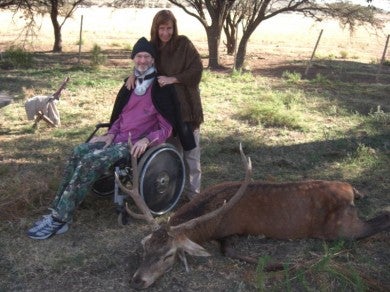
Despite increasing paralysis caused by ALS, I was back in Argentina for the April 2012 roar. This time I stayed at Caza Pampa Lodge (which offers handicapped-accessible facilities) and hunted during daylight hours. While the lodge’s other guests—including an 82-year-old gentleman—went off to stalk stags in the thick stuff, my guide Jorge Braun and I staked out clearings and food plots. We hid behind natural blinds built on the spot with brush and fallen branches.
One afternoon we were watching two hinds on a food plot when a stag made the mistake of emerging from the scrub to check on his ladies. For several long minutes it remained partially hidden behind a bush, and then the big boy finally came all the way out in the open. Jorge aimed the .308 for me while we both viewed the sight picture on a special monitor; as the crosshairs held steady on the stag’s shoulder, I activated the trigger control by inhaling on a tube.
Jorge must not have had total confidence in my adaptive shooting gear because he seemed genuinely surprised when the stag collapsed. Though not my largest red deer, this one (another 5×5) caused quite a commotion as the other guides and hunters at the lodge congratulated me on my perseverance and success.
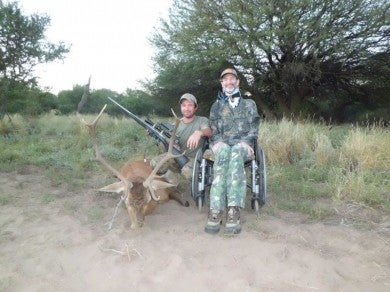
Info and Insights
Red deer originally inhabited Europe and were the noble quarry of kings. Argentina owes its population of red deer to a wealthy rancher named Pedro Luro, who brought over a small herd from Germany and Scotland in 1920. The deer flourished in the central Argentinean province of La Pampa, where they’re called ciervo rojo or ciervo colorado, and now the chance to hunt them here draws sportsmen from around the world.
Rutting season begins in mid-March and continues through mid-April, giving hunters a month-long window to experience the excitement of the roar. Rifle hunters find .270, .30-06, .300 or similar calibers adequate for red stag, which grow to 400 pounds or more. Bowhunting is legal, but the typically windy conditions can frustrate archers.
Mike Malek has been pursuing stags every season since 2005, and he offers these insights based on his experience:
“While the average daytime temperature in La Pampa during the roar is around 80 degrees, over the years I’ve hunted in conditions that ranged from below freezing to more than 100 degrees. Pack warm-weather hunting clothes, but bring layers so you can shed or add clothing as necessary. Hunters should also bring a pair of binoculars, shooting sticks, good-quality hunting boots, and calf-high gaiters to protect your shins from thorns and ever-present burrs. Although it rarely rains, a set of light rain gear is always good to have along too.”
Argentine law requires outfitters to register harvested stags with the federal government before antlers can be transported, and the bureaucracy prevents hunters from personally carrying trophies home. “If there is a weak link in the South American hunting experience, it is the export process,” Malek says. “The typical cost to get a red stag trophy to the U.S. is around $1,500, and it can take up to a year. Fortunately things are changing. Hunters are demanding better service and there’s now more competition in the export brokerage business. Last season my clients all got their trophies back within six months.”
